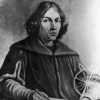Nicolaus Copernicus

Nicolaus Copernicus
Nicolaus Copernicus; German: Nikolaus Kopernikus; 19 February 1473 – 24 May 1543) was a Renaissance mathematician and astronomer who formulated a model of the universe that placed the Sun rather than the Earth at the center of the universe. The publication of this model in his book De revolutionibus orbium coelestiumjust before his death in 1543 is considered a major event in the history of science, triggering the Copernican Revolution and making an important contribution to the Scientific Revolution...
NationalityPolish
ProfessionScientist
Date of Birth19 February 1473
CountryPoland
Of all things visible, the highest is the heaven of the fixed stars.
The Universe has been wrought for us by a supremely good and orderly Creator
I can easily conceive, most Holy Father, that as soon as some people learn that in this book which I have written concerning the revolutions of the heavenly bodies, I ascribe certain motions to the Earth, they will cry out at once that I and my theory should be rejected.
Astronomy is written for astronomers
More stars in the north are seen not to set, while in the south certain stars are no longer seen to rise.
The two revolutions, I mean the annual revolutions of the declination and of the centre of the Earth, are not completely equal; that is the return of the declination to its original value is slightly ahead of the period of the centre. Hence it necessarily follows that the equinoxes and solstices seem to anticipate their timing, not because the sphere of the fixed stars moves to the east, but rather the equatorial circle moves to the west, being at an angle to the plane of the ecliptic in proportion to the declination of the axis of the terrestrial globe.
Since, then, there is no objection to the mobility of the Earth, I think it must now be considered whether several motions are appropriate for it, so that it can be regarded as one of the wandering stars. For the fact that it is not the centre of all revolutions is made clear by the apparent irregular motion of the wandering stars, and their variable distances from the Earth, which cannot be understood in a circle having the same centre as the Earth.
I shall now recall to mind that the motion of the heavenly bodies is circular, since the motion appropriate to a sphere is rotation in a circle.
If there be some who, though ignorant of all mathematics . . . dare to reprove this work, because of some passage of Scripture, which they have miserably warped to their purpose, I regard them not, and even despise their rash judgement.
First of all, we must note that the universe is spherical.
When, therefore, I had long considered this uncertainty of traditional mathematics, it began to weary me that no more definite explanation of the movement of the world-machine established in our behalf by the best and most systematic builder of all, existed among the philosophers who had studied so exactly in other respects the minutest details in regard to the sphere.
For when a ship is floating calmly along, the sailors see its motion mirrored in everything outside, while on the other hand they suppose that they are stationary, together with everything on board. In the same way, the motion of the earth can unquestionably produce the impression that the entire universe is rotating.
So, influenced by these advisors and this hope, I have at length allowed my friends to publish the work, as they had long besought me to do.
I therefore took this opportunity and also began to consider the possibility that the Earth moved. Although it seemed an absurd opinion, nevertheless, because I knew that others before me had been granted the liberty of imagining whatever circles they wished to represent the phenomena of the stars, I thought that I likewise would readily be allowed to test whether, by assuming some motion of the Earth's, more dependable representations than theirs could be found for the revolutions of the heavenly spheres.